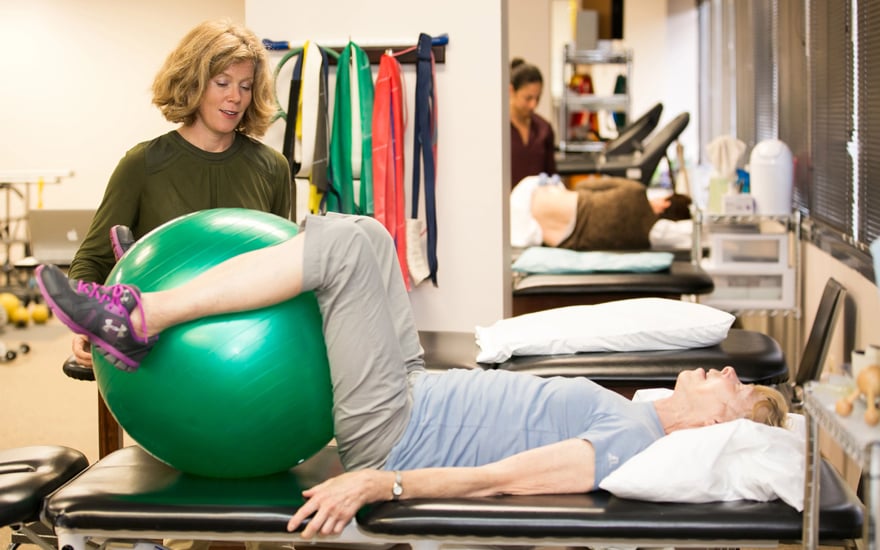Physical Therapy Guide to Low Back Pain
If you have low back pain, you are not alone. At any given time, about 25% of people in the United States report having had low back pain within the past three months. In most cases, low back pain is mild and disappears on its own. For some people, back pain can return or hang on, leading to a decrease in quality of life or even disability. Physical therapists help people with low back pain improve or restore mobility and reduce their pain. And, according to a new study, choosing physical therapy for low back pain outperforms usual primary care and is cost-effective.
Physical therapists are movement experts. They improve quality of life through hands-on care, patient education, and prescribed movement. You can contact a physical therapist directly for an evaluation. To find a physical therapist in your area, visit Find a PT.
What Is Low Back Pain?
Low back pain is defined by its location, typically the area between the lower ribs and buttock crease. The symptoms of low back pain vary a great deal. Your pain might be dull, burning, or sharp. You might feel it at a single point or over a broad area. Low back pain can occur along with muscle spasms or stiffness. Sometimes, it spreads into one or both legs.
There are three different types of low back pain:
- Acute: pain lasting less than three months.
- Recurrent: acute symptoms that ease up, then come back.
- Chronic: pain lasting longer than three months.
Most people who have an episode of acute low back pain will have at least one recurrence. While the cause of low back pain isn't always known, its symptoms can resolve on their own.
Research shows that personal factors, such as self-confidence and perceived ability to cope with disability, may be predictive of who may not recover as expected from low back pain. In the past, low back pain was thought to be related directly to just the physical aspects of our body. We now understand the condition to be much more complex.
Low back pain is rarely serious or life-threatening. However, the following serious conditions may be linked to low back pain:
- Lumbar spinal stenosis.
- Osteoarthritis.
- Herniated disk.
- Fractures.
- Tumors of the spine.
- Infection.
Although these conditions can directly contribute to low back pain, they also can be present in people without any pain. If your physical therapist suspects a more serious health condition is causing your pain, they will refer you to other health care specialists for further evaluation.
If you are having low back pain right now:
- Stay active and do as much of your normal routine as possible. Bed rest for longer than one day can slow your recovery.
- If your pain lasts more than a few days or gets worse, schedule a visit with a physical therapist.
If you have low back pain along with the following symptoms, visit your local emergency department at once:
- Loss of bowel or bladder control.
- Numbness in the groin or inner thigh.
Together, these symptoms may point to a condition called cauda equina syndrome, in which the spinal nerves that control the bowel and bladder are being squeezed.
How Is It Diagnosed?
Your physical therapist will perform a thorough evaluation and physical exam that includes:
- A review of your health history.
- Questions about your specific symptoms.
- Assessing the quality and quantity of your movements. Physical therapists also can address any movement behaviors that might put you at risk for delayed recovery.
- Conducting tests for any signs or symptoms that suggest a serious health problem, such as broken bones or cancer.
- Assessment of how you use your body at work, at home, during sports, and at leisure.
For most cases of low back pain, imaging tests such as X-rays, CT scans, and MRIs are not helpful. It often is frustrating for patients when imaging tests don’t reveal the actual cause of their low back pain. Fortunately, however, low back pain can get better without a visual assessment of its cause.
How Can a Physical Therapist Help?

Your physical therapist can help you improve or restore mobility and reduce your low back pain. In many cases, they help people avoid expensive surgery and the risks and side effects of prescribed medications.
Not all low back pain is the same. You should receive treatment tailored to you and your specific symptoms and condition. Your physical therapist will:
- Take your health history and note your current symptoms.
- Complete a thorough physical examination and evaluate the results.
- Identify any factors that have contributed to your specific back problem.
- Design a personalized treatment plan for you. Physical therapists are experts at providing pain relief that reduces the need for medications, including opioids.
Physical therapists can use a variety of techniques to address each person’s pain. Your physical therapy treatment may include:
- Manual therapy, including spinal manipulation, using their skilled hands to improve the mobility of joints and soft tissues.
- Specific strengthening and flexibility exercises personalized to your body, needs, and goals.
- Education about how you can take better care of your back.
- Training on proper lifting, bending, and sitting. This may include recommending ways to do chores at work and at home, and proper sleeping positions.
- Developing a safe and effective physical activity program for you to do your own to improve your overall health.
- Use of ice or heat treatments or electrical stimulation to help relieve pain.
Learn more about recommended treatments for low back pain.
A wealth of research has shown that physical therapy is an effective treatment for acute low back pain. In a recent study, researchers calculated the economic impact of choosing physical therapy for acute low back pain over usual care. They found that doing so saves $4,160, including all the hidden costs of your time, pain, missed life events, and the dollars paid for services. Early physical therapy can give you the knowledge you need to take care of your back and reduce the need for prescribed opioids.
Also see:
Can This Injury or Condition Be Prevented?
As experts in restoring and improving mobility and movement, physical therapists play an important role in treating chronic or recurrent low back pain. They also can help you reduce the risk for having an episode of low back pain in the first place (prevention), educate you on how to manage it if it occurs, and minimize your risk of having it come back or become chronic.
Your physical therapist can teach you strategies for prevention and management of low back pain that may include:
- Using proper body positioning at work, home, or during leisure activities.
- Keeping any load (items that are heavy) close to your body during lifting.
- Asking for help before lifting heavy and awkward objects.
- Maintaining a regular physical activity and fitness regimen.
Evidence suggests that pain can develop for reasons beyond injury to the body’s tissue. Understanding why we feel pain and how to address it when it arises are the best strategies to prevent disability and improve self-management of low back pain. Learn more about pain.
What Kind of Physical Therapist Do I Need?
All physical therapists are prepared through education and experience to treat people who have low back pain. You may want to consider:
- A physical therapist who is experienced in treating people with orthopedic or musculoskeletal problems.
- A physical therapist who is a board-certified clinical specialist, or who completed a residency or fellowship in orthopedic physical therapy. This physical therapist has advanced knowledge, experience, and skills that may apply to your condition.
You can find physical therapists who have these and other credentials by using Find a PT, the online tool built by the American Physical Therapy Association to help you search for physical therapists with specific clinical expertise in your geographic area.
General tips when you're looking for a physical therapist (or any other health care provider):
- Get recommendations from family and friends or from other health care providers.
- When you contact a physical therapy clinic for an appointment, ask about the physical therapists' experience in helping people with low back pain.
- Be prepared to describe your symptoms in detail and say what makes your symptoms worse.
The American Physical Therapy Association believes that consumers should have access to information that could help them:
- Make informed health care decisions.
- Prepare them for a visit with their health care provider.
The following articles offer some of the best scientific evidence related to physical therapy treatment of low back pain. The articles report recent research and give an overview of the standards of practice both in the United States and internationally. The articles link either to a PubMed* abstract or the free full text. You can read them or print out a copy to bring to your health care provider.
Marrache M, Prasad N, Margalit A, et al. Initial presentation for acute low back pain: is early physical therapy associated with healthcare utilization and spending? A retrospective review of a national database. BMC Health Serv Res. 2022;22(1):851. Article Summary in PubMed.
George SZ, Fritz JM, Silfies SP, et al. Interventions for the management of acute and chronic low back pain: revision 2021. J Orthop Sports Phys Ther. 2021;51(11):CPG1–CPG60. Article Summary in PubMed.
Managing low back pain: exercise, manual therapy, and education. J Orthop Sports Phys Ther. 2021;51(11):535. Article Summary in PubMed.
Magel J, Kim J, Fritz JM, Freburger JK. Time between an emergency department visit and initiation of physical therapist intervention: health care utilization and costs. Phys Ther. 2020;100(10):1782–1792. Article Summary in PubMed.
Frogner BK, Harwood K, Andrilla CH, et al. Physical therapy as the first point of care to treat low back pain: an instrumental variables approach to estimate impact on opioid prescription, health care utilization, and costs. Health Serv Res. 2018;53(6):4629–4646. Article Summary in PubMed.
Magel J, Kim J, Thackeray A, et al. Associations between physical therapy continuity of care and health care utilization and costs in patients with low back pain: a retrospective cohort study. Phys Ther. 2018;98(12):990–999. Article Summary in PubMed.
Qaseem A, Wilt T, McLean R, et al. Noninvasive treatments for acute, subacute, and chronic low back pain: a clinical practice guideline from the American College of Physicians. 2017;166(7):514-530. Article Summary in PubMed.
Childs JD, Fritz JM, Wu SS, et al. Implications of early and guideline adherent physical therapy for low back pain on utilization and costs [published correction in: BMC Health Serv Res. 2016;16:444]. BMC Health Serv Res. 2015;15:150. Article Summary in PubMed.
Foster NE, Mullis R, Hill JC, et al. Effect of stratified care for low back pain in family practice (IMPaCT Back): a prospective population-based sequential comparison. Ann Fam Med. 2014;12:102–111. Article Summary in PubMed.
*PubMed is a free online resource developed by the National Center for Biotechnology Information. PubMed holds millions of citations to biomedical literature, including citations in the National Library of Medicine’s MEDLINE database.
Expert Review:
Jun 11, 2023
Revised:
Jun 29, 2023
Content Type: Guide
Low Back Pain
Laura Thornton
PT, DPT, board-certified clinical specialist in orthopaedic physical therapy
You Might Also Like...
Health Tips
6 Tips to Prevent New Parenting InjuriesJun 21, 2024
Get tips from physical therapists for how to prevent strains and injury (including low back pain) when caring for a newborn.
Health Tips
Pregnancy Pains: Causes, Solutions, and Comprehensive ReliefJun 17, 2024
Pregnancy can be an exciting and joyous experience. It also can come with discomfort and health concerns. Learn about the causes of pain during pregnancy
Health Tips
Dry Needling by a Physical Therapist: What You Should KnowMay 31, 2024
Dry needling is a technique that some physical therapists use to treat pain and movement impairments. It is not the same as acupuncture. Learn how physical


